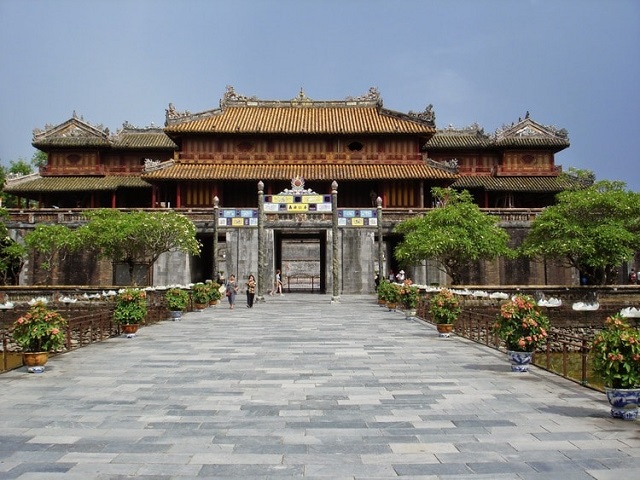Meridian Gate is both the main gate and the face of the citadel. Despite the difficult time of war and extreme weather, thanks to meticulous construction technique and especially architectural art, Meridian Gate has still been well preserved to become the typical ancient architecture of Hue.
Meridian Gate: Architectural Symbol Of Hue Ancient Capital
1. Meaning And Origin Of Meridian Gate
It is the main southern gate of Hue imperial citadel. Meridian Gate is now one of the architectural monuments of the Nguyen Dynasty belonging to Hue ancient capital’s monument complex. Meridian Gate or “cổng tý ngọ” – toward the south is the largest gate among four main gates of Hue imperial citadel. This gate is only for the kings or is used to receive envoys.
The throne in Thai Hoa Palace is considered the central location. Meridian Gate lies on its southern. According to the compass of Oriental geomancy, the south is the “ngọ” direction on “tý-ngọ” axis (means “North-South”). Therefore, Emperor Minh Mang named the new central gate in front of the imperial city “Meridian Gate” to alter the old name- “Nam Khuyết Ðài” (the southern side of the watchtower). Meridian gate should be referred to as the south gate with the meaning of space, not about time – “ngọ” hour (at noon). That is the reason why Meridian Gate cannot be translated into “Noon time gate”.
History of Meridian Gate:

Source: lolivi
The place was initially “Nam Khuyết Đài” built at the beginning of Emperor Gia Long. On the watchtower, there is Càn Nguyên temple with two gates –Tả Đoan Môn and Hữu Đoan Môn in two sides. Until the 14th year of Emperor Minh Mang (1883), when Nguyen Dynasty planned to repair the whole structure of the imperial city, Nam Khuyết Đài was removed entirely to build Meridian gate. Etymologically, Meridian gate is defined as “the gate toward the south”. According to translation, the south is the direction of kings to rule the country, or it can be said: “nhi thính thiên hạ, hướng minh nhi trị” (toward the light of truth and moral to listen to the public and rule the country lucidly).
2. Architecture Of Meridian Gate
The gate includes two main parts: the tower and Ngũ Phụng pavilion
The tower:
The gate is similar to the perpendicular U shape with the basement of 57.77m, and the next side is 27.6m long. The mixture of brick, stone and brass beams was used to build the tower. The tower is nearly 5m high and accounts for 1560 square meters (including the inner). The tower officially opened five entrances. The middle one was Meridian Gate only used to serve the Kings. Two sides are Tả Giáp Môn and Hữu Giáp Môn for civil and military mandarins.
Ngũ Phụng Pavilion:

Source: blogspot
Ngũ Phụng pavilion is the pavilion lying above the tower-gate. Besides the body of the tower, this pavilion was heightened by the 1.15-meter-high base system. The pavilion consists of two floors; the iron wooden frame structure has 100 pillars.
The roof in the lower floor is interconnected. The roof in the upper floor is divided into nine sets with phoenix patterns decorated in the top and edges, which makes the pavilion soft and natural. The main roof in the middle of Ngũ Phụng pavilion is tiled with golden glazed tiles and the eight roofs are tiled with blue glazed tiles.
3. Main Function Of Meridian Gate
In the past, the gate was closed all year. It opened when the king entered the imperial citadel and was kept accompanied with “đoàn ngự đạo” (an imposing procession of elephants, soldiers and some instruments), and occasions of receiving prominent foreign envoys in the royal palace.
Meridian Gate is just a typical gate, but such a complicated architectural complex. Ngũ Phụng pavilion was considered the platform to organize annual ceremonies of the court featuring Truyền Lô ceremony (to honour candidates passed the examinations), Ban Sóc ceremony, Parade ceremony. Also, Meridian Gate was the place to occur the event “Bao Dai King’s throne abdication” on August 30th 1945.
4. Architectural Values Of Meridian Gate

Source: blogspot
The gate is the icon of techniques and construction standard at that time. With the application and combination of domestic materials, engineers and craftsmen created a sustainable construction work for centuries. Meridian Gate is also the symbol of local and national architecture- sculpture – typical for Nguyen Dynasty’s architecture in particular and traditional Vietnam architecture in general. It is traditionally regarded as the masterpiece –the best architecture of Hue imperial court. It was the former icon of the prosperous imperial citadel and the feudal dynasty. However, Meridian Gate becomes the representation of Hue, the consistently beautiful image of the ancient capital.
It will be such a good opportunity for those people who are keen on history interest, especially the feudal dynasty to discover the architectural monument complex. Meridian Gate is worth visiting when tourists take a trip to Hue!